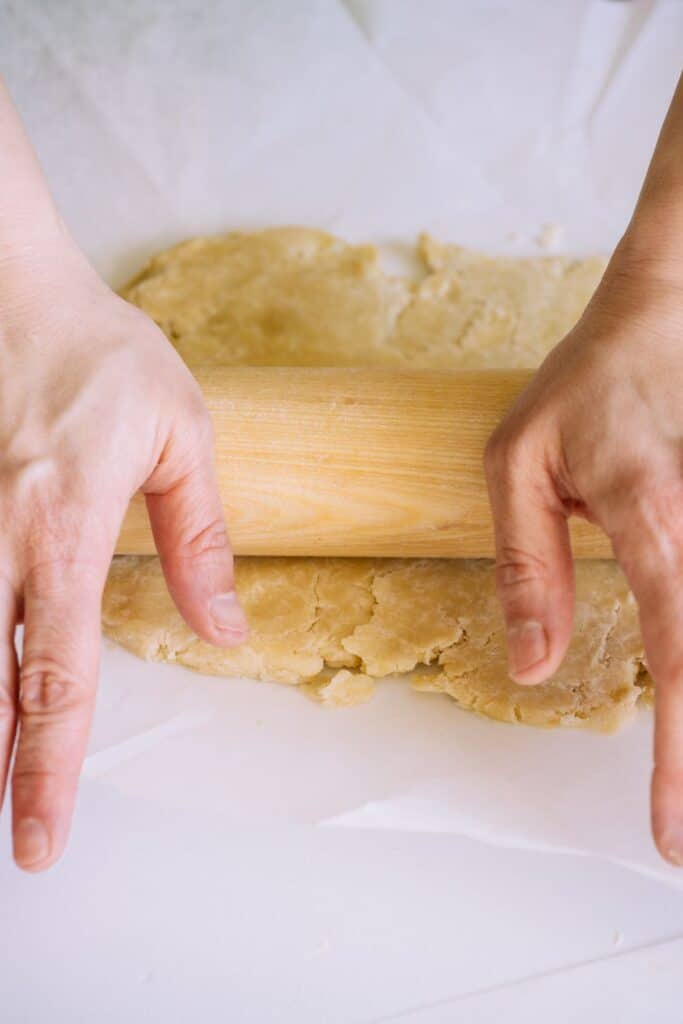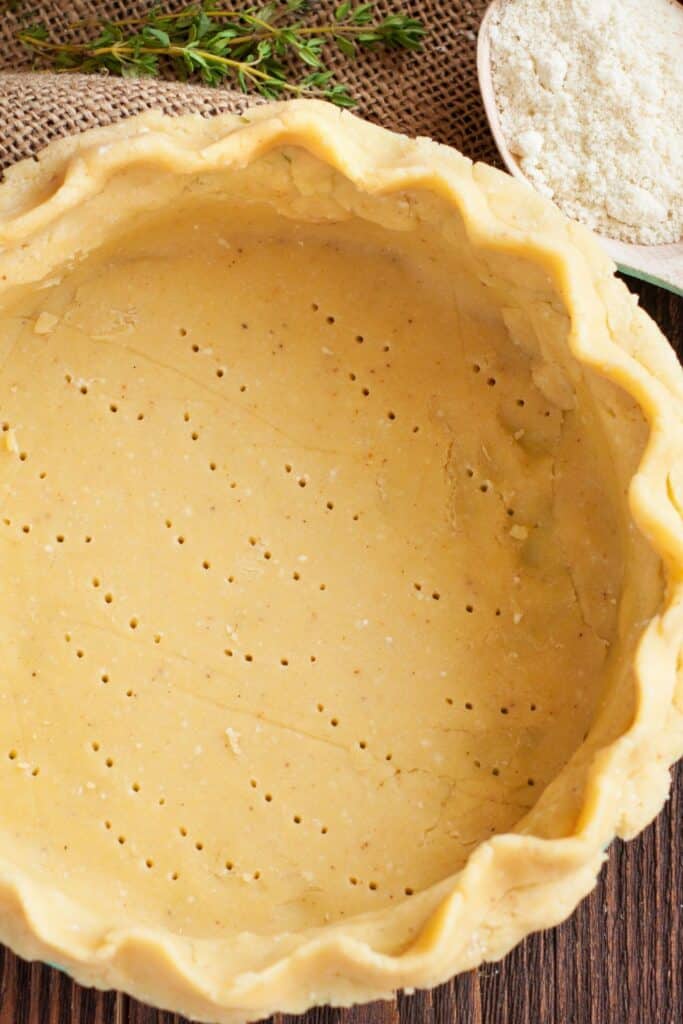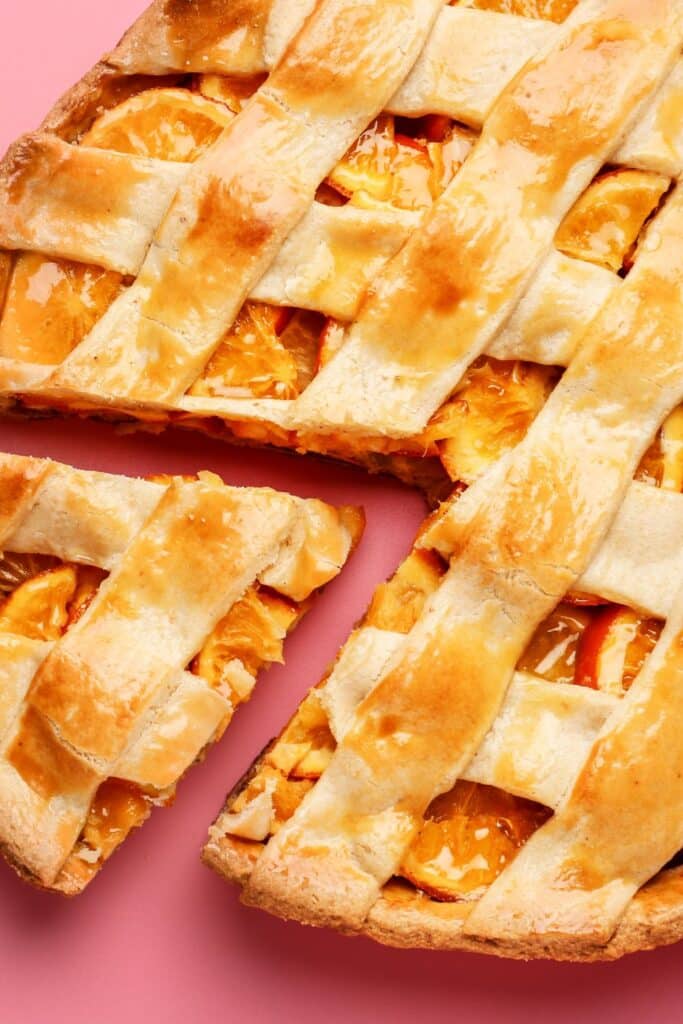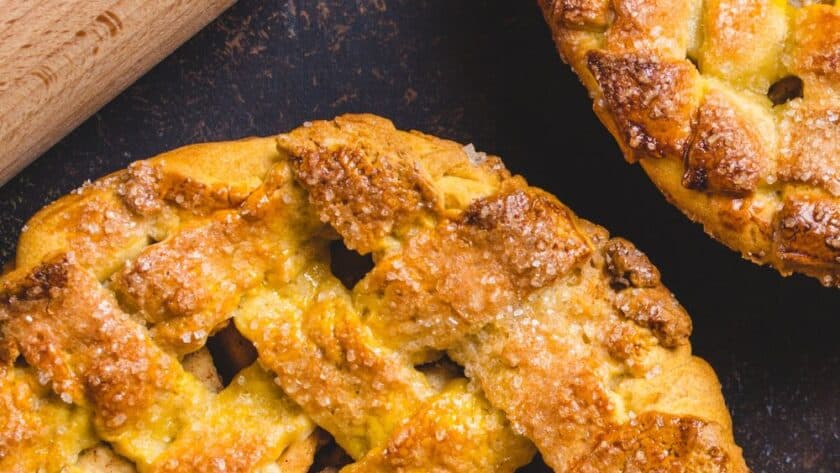I am overjoyed to introduce you to the simplest version of my go-to Joanna Gaines pie crust recipe. Even if you have never attempted to make homemade pie crust before, yours will turn out beautifully buttery, tender, flaky, and delicious thanks to the step-by-step instructions, tips, and tricks that I have included. If you’ve never made pie crust before, let me reassure you that it’s as simple as “easier than (making) pie”!
What Is Pie Crust?
A baked dish known as a pie crust is typically constructed out of a casing made of pastry dough and typically encases a filling made of a variety of sweet or savory ingredients. Fillings for sweet pies can range from fruit (as in an apple pie), nuts (as in a pecan pie), brown sugar (as in a sugar pie), or sweetened vegetables (as in a rhubarb pie) to more substantial fillings made from eggs and dairy products. The filling of savory pies can consist of meat (such as in a steak pie or a Jamaican patty), eggs and cheese (in the form of a quiche), or a combination of meat and vegetables.

Joanna Gaines Pie Crust Recipe Ingredients
- Butter. When making baked products, you should never use salted butter.
- Flour. Because I’ve only tried making this homemade pie shell recipe with all-purpose flour, I can’t comment on how well it would turn out if you used gluten-free flour instead.
- Granulated Sugar. in its granular form Only one tablespoon is needed to infuse the crust with taste and sweetness.
- Salt. Boosts the flavor of the topping on the crust.
- Vegetable shortening. When purchasing vegetable shortening, be sure to pick the one that is unflavored.
- Water. It must be quite chilly.

How To Make Joanna Gaines Pie Crust Recipe
- In a large bowl, combine the flour and salt by whisking.
- Butter and shortening. Cut butter and shortening into the mixture using a pastry cutter or two forks (pea-sized bits with a few larger bits of fat is OK). In this step, you break up cold fat into flour-coated particles but don’t fully incorporate it. Ingredients shouldn’t be overworked.
- 1/2 cup (120ml) of water. Frost. Mix. Since the ice has melted, measure 1/2 cup (120ml) water. After each Tablespoon, mix with a spatula or wooden spoon. When dough clumps, stop adding water. I use 1/2 cup of water, and more in dry winter months. Add just enough water.
- The pie dough should be floured. Fold the dough with floured hands until the flour and fats are combined. The dough should cling together easily. Don’t overwork dough. If it’s too dry or crumbly, dip your fingers in ice water and knead it.
- If it’s too sticky, add flour and knead it with your hands. Roll it. Half it with a knife. 1 pound, 8 oz dough should be enough (about 680g). Each half should be 1 inch thick.
- Wrap it up in plastic wrap, and do it good. Store in the fridge for at least 2 hours and up to 5 days.
- After 2 hours, roll out the dough. Work with one crust at a time; refrigerate the other. Flour your work surface, rolling pin, hands, and dough.
- Don’t roll the dough too hard; you’re not upset at it. Start from the center and roll outward, rotating the dough with your hands. Rotate and flip the pie dough between rollings to prevent sticking. If it’s sticking, add additional flour; don’t be frightened.
- If the dough becomes uneven when rolling it out, put down the rolling pin and use your hands to shape it. Roll dough into a 12-inch circle to fit a 9-inch pie dish. You’ll have 1/8-inch-thick pie dough. Butter and fat flecks in dough are natural.
- Because the dough is so thin, roll it into the pie plate. Roll one end of the dough round onto the rolling pin, rolling it back towards you as you go. Carefully reroll it over the pie dish.
Recipe Tips
- The components should be chilled. Keeping the fat cold until it enters the oven is what guarantees a flaky crust as opposed to a crunchy one, so we need to make sure our shortening, butter, and water are very cold. Fat pellets that melt before baking release steam that opens holes in the dough and produces flaky layers, as described in Baking Illustrated.
- Never handle the dough more than necessary. If you can avoid touching the pie crust too much after blending the ingredients in a food processor, that would be ideal. This will help keep the butter cold and prevent the flour from becoming tough, two crucial factors in achieving a fluffy pie crust.
- Produce a pie crust that has already been baked. Fill the dough with dried beans or pie weights and cover it with parchment paper (this keeps crust from shrinking). Bake for 25-30 minutes, or until the dough is dry and pale. After 12-18 minutes more baking time has passed with the parchment paper and weights removed, the pastry should be dry and a golden brown. Put on a cooling rack to allow them cool completely before stuffing.

What To Serve With Joanna Gaines Pie Crust
Here are some suggestions for what you can serve with Joanna Gaines’ pie crust recipe:
- Fruit Pies: Fill the pie crust with a variety of fresh or cooked fruits such as apple, cherry, blueberry, peach, or strawberry. Serve the pie with a dollop of whipped cream, a scoop of vanilla ice cream, or a drizzle of caramel sauce.
- Cream Pies: Use the pie crust for cream-based pies like banana cream, coconut cream, or chocolate cream. Top the pie with whipped cream, grated chocolate, or toasted coconut flakes.
- Pumpkin Pie: The pie crust works wonderfully with pumpkin pie filling. Serve it with a dusting of powdered sugar, a dollop of whipped cream, or a sprinkle of cinnamon.
- Pecan Pie: Fill the pie crust with a rich pecan filling and bake it to perfection. Serve it with a scoop of vanilla ice cream or a drizzle of warm caramel sauce.
- Quiches: Use the pie crust to make savory quiches with various fillings like spinach and feta, bacon and cheese, or mushroom and caramelized onion. Serve quiches with a side salad or fresh fruit.
How To Store Joanna Gaines Pie Crust Recipe?
In The Fridge:
A freshly baked pie crust can be stored in the fridge for up to five days without losing any of its quality as long as it is tightly wrapped in plastic wrap or stored in an airtight container.
In The Freezer:
You can freeze the pie crust for up to two months. You can make a frozen pot pie by placing it in the freezer for several hours. As soon as the food has cooled, take it out of the freezer and store it in an airtight container or bag.
How To Reheat Joanna Gaines Pie Crust Recipe?
In The Oven:
- Raise the temperature in your oven to three hundred degrees. In order to maintain its temperature, the pie crust should be wrapped in aluminum foil.
- Take the foil off your chicken pot pie after it has been in the oven for ten minutes, and then continue cooking the pie.
- Bake for an additional 5–10 minutes, or until the filling has reached the temperature you want it to be at and the crust has developed a flaky texture.
In The Microwave:
- After slicing the pie crust into bite-sized pieces, arrange them in a pattern on a plate that is safe for cooking in the microwave.
- After it has been heated for two minutes in the microwave, check the temperature to see if it has changed.
- Give it an additional 30 seconds in the microwave if the temperature has not been evenly distributed throughout.
- Proceed in the same manner with the remaining portion of the pie, and after you’re done, savor it!
How To Make Joanna Gaines Pie Crust Recipe Ahead?
Complete the preparation of the pie dough up to then freeze the discs for up to three months. Before you use it in your pie recipe, let it thaw in the refrigerator for a full night.
What Are The 5 Types Of Pie?
- Double-Crust Fruit Pie.
- Cream Pie.
- Custard Pie.
- Meringue Pie.
- Tart.
- Galette.
- Chiffon Pie.
- Ice Cream Pie.
Should I Spray A Pie Pan Before Putting In Crust?
The short answer to this question is often not. My own recipe, which was mentioned above, contains more than enough fat to prevent it from sticking to your teeth. I would consider giving your pan a light spritz of cooking spray or brushing with a little softened butter if you are going to be using a store-bought pie crust; however, you should not do either of these things if you are going to be using a homemade pie crust.
Do You Cook Pie Crust First Before Filling?
However, prebaking the pie crust is the one and only surefire technique to make absolutely certain that the crust of your pie will be golden brown, crisp, and tasty — just as appealing as the filling of your pie. That’s accurate; you should bake the bottom crust first, then add the filling after it has cooled.
Joanna Gaines Pie Crust Nutrition Facts
Amount Per Serving
- Calories 782
- Total Fat 44g
- Saturated Fat 14g
- Cholesterol 0mg
- Sodium 719mg
- Potassium 176mg
- Total Carbohydrate 87g
- Protein 10g
- Vitamin A 0%
- Vitamin C 0%
- Calcium 2.5%
- Iron 24%
Try Other Joanna Gaines Recipes:
Joanna Gaines Pie Crust Recipe
Description
I am overjoyed to introduce you to the simplest version of my go-to Joanna Gaines pie crust recipe. Even if you have never attempted to make homemade pie crust before, yours will turn out beautifully buttery, tender, flaky, and delicious thanks to the step-by-step instructions, tips, and tricks that I have included. If you’ve never made pie crust before, let me reassure you that it’s as simple as “easier than (making) pie”!
Ingredients
Instructions
- n a large bowl, combine the flour and salt by whisking.
- Butter and shortening. Cut butter and shortening into the mixture using a pastry cutter or two forks (pea-sized bits with a few larger bits of fat is OK). In this step, you break up cold fat into flour-coated particles but don’t fully incorporate it. Ingredients shouldn’t be overworked.
- 1/2 cup (120ml) of water. Frost. Mix. Since the ice has melted, measure 1/2 cup (120ml) water. After each Tablespoon, mix with a spatula or wooden spoon. When dough clumps, stop adding water. I use 1/2 cup of water, and more in dry winter months. Add just enough water.
- The pie dough should be floured. Fold the dough with floured hands until the flour and fats are combined. The dough should cling together easily. Don’t overwork dough. If it’s too dry or crumbly, dip your fingers in ice water and knead it.
- If it’s too sticky, add flour and knead it with your hands. Roll it. Half it with a knife. 1 pound, 8 oz dough should be enough (about 680g). Each half should be 1 inch thick.
- Wrap it up in plastic wrap, and do it good. Store in the fridge for at least 2 hours and up to 5 days.
- After 2 hours, roll out the dough. Work with one crust at a time; refrigerate the other. Flour your work surface, rolling pin, hands, and dough.
- Don’t roll the dough too hard; you’re not upset at it. Start from the center and roll outward, rotating the dough with your hands. Rotate and flip the pie dough between rollings to prevent sticking. If it’s sticking, add additional flour; don’t be frightened.
- If the dough becomes uneven when rolling it out, put down the rolling pin and use your hands to shape it. Roll dough into a 12-inch circle to fit a 9-inch pie dish. You’ll have 1/8-inch-thick pie dough. Butter and fat flecks in dough are natural.
- Because the dough is so thin, roll it into the pie plate. Roll one end of the dough round onto the rolling pin, rolling it back towards you as you go. Carefully reroll it over the pie dish.
Servings 4
- Amount Per Serving
- Calories 782
- Calories from Fat 396
- % Daily Value *
- Total Fat 44g68%
- Saturated Fat 14g70%
- Sodium 719mg30%
- Potassium 176mg6%
- Total Carbohydrate 87g29%
- Dietary Fiber 5.1g21%
- Sugars 6.5g
- Protein 10g20%
- Calcium 2.5 mg
- Iron 24 mg
* Percent Daily Values are based on a 2,000 calorie diet. Your daily value may be higher or lower depending on your calorie needs.

